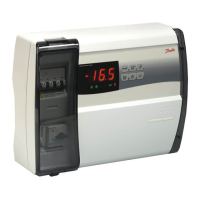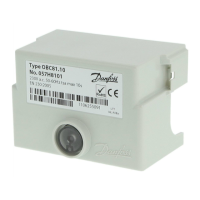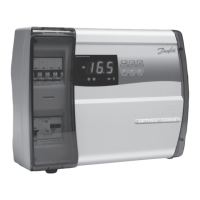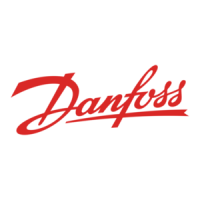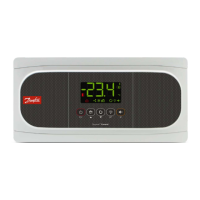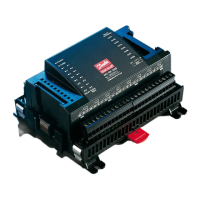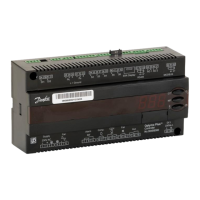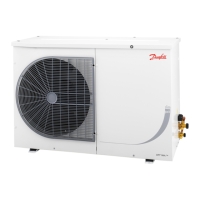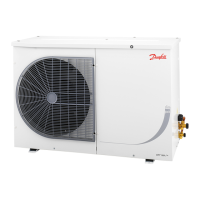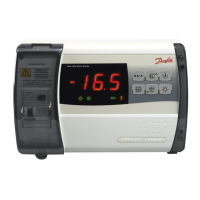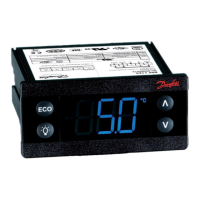Do you have a question about the Danfoss Optyma Plus and is the answer not in the manual?
| Type | Electronic controller |
|---|---|
| Protection class | IP20 |
| Communication | Modbus RTU |
| Ambient temperature range | -10 - 55 °C |
| Storage temperature range | -20 - 70 °C |
Defines the controller's use for condensing unit control.
Lists benefits like pressure control, fan speed, and compressor regulation.
Explains how the controller receives signals and manages cooling demands.
Outlines primary functions such as temperature, fan, and compressor control.
Details regulation relative to ambient temperature and set points.
Describes the internal clock for switching between day and night settings.
Controls fan speed via terminal 5-6 with relay activation at high speeds.
Uses an external 0-10V signal for fan speed control via terminal 54-55.
Sets initial fan speed ('Jog Speed') for 10 seconds upon restart.
Maintains a minimum fan speed ('FanMinSpeed') for loads between 10-30%.
Lowers fan amplification factor for smoother regulation in cold ambient conditions.
Controls compressor via DI1, with restrictions to prevent frequent cycling.
Manages compressor capacity and fan speed based on Td sensor readings.
Activates liquid injection to manage discharge temperature near maximum limits.
Monitors condensing pressure and stops compressor if limits are exceeded.
Stops compressor on low suction pressure after minimum ON time.
Stops the compressor when suction pressure falls below a defined set value.
Thermostat function to keep oil separate from refrigerant via a heating element.
Details the uses of DI1, DI2, and DI3 for various control and safety functions.
Built-in MODBUS and optional LON RS485 for data exchange.
Connects EKA 163B/164B displays for readings and operation.
Enables control integration with master gateways or system managers.
Shows Ts/Tc and allows selection of SI or US units.
Sets the reference temperature and day/night offset.
Manual control options and standby alarm notification.
Adjusts reference for night operation and suction pressure.
Defines minimum and maximum permitted condensing temperatures.
Manages max Td, fan speed, and alarm delays.
General alarm indication and timing for DI2 input alarms.
Sets minimum ON-time, OFF-time, and restart intervals for compressor.
Defines compressor stop pressure and minimum/start speeds.
Sets max speed limits and reduced speed during night operation.
Configures control modes and delay for high discharge gas temperature.
Sets maximum condensing and minimum suction pressures.
Defines re-start differences and PI regulation parameters.
Configures activation and deactivation points for liquid injection.
Settings for fan speed regulation, including amplification factor.
Tuning parameters for fan speed changes and amplification.
Configures initial fan speed and low-temperature jog speed.
Selects fan control type and sets speed limits.
Allows manual override of fan speed.
Settings for day/night switch times and clock date/time.
Configures network address and access code for security.
Configures display signal and Ps/Pc transmitter ranges.
Selects refrigerant and defines D2 input functionality.
Sets unit type and configures S3 for discharge gas temperature.
Saves current settings and defines Taux sensor function.
Sets timing and power points for the crankcase heating element.
Reads unit, compressor, and heating element operating times and alarm counts.
Tracks LP/discharge alarms and sets speed limit for oil return.
Configures time limits and boost speed for oil return management.
Lists service functions for reading various parameters and statuses.
Explains status codes for normal regulation and compressor activity.
Details status codes for refrigeration stopped by switch or manual control.
Covers status codes for missing refrigerant and safety cut-outs.
Indicates status for password, stopped regulation, and unit type selection.
Lists fault codes and actions for data communication.
Configures alarm importance and destinations for data communication.
Explains display values and front panel LED indicators.
Guides users on how to navigate menus and change settings.
Provides step-by-step examples for setting parameters and set points.
Outlines steps for a fast initial setup and regulation start.
Presents a summary table of functions, parameters, and settings.
Lists specific min/max values for alarm and compressor parameters.
Details settings for regulation tuning, fan control, and real-time clock.
Provides settings for network address and access codes.
Detailed settings for display, inputs, and refrigerant selection.
Configures unit type, Taux sensor, and saves factory settings.
Sets crankcase heating timing and tracks operating hours.
Configures oil return parameters and reads alarm counts.
Lists various service functions for reading system status and parameters.
Details wiring for DI inputs and pressure transmitters (Pc, Ps).
Covers sensor wiring and EKA display/RS485 connections.
Wiring for AO outputs, MODBUS, and supply voltage.
Wiring for Alarm, Comp, CCH, Fan, Aux relays, and DI3 input.
Guidelines for minimizing electrical noise and proper installation practices.
Electrical supply, sensor types, and measuring ranges.
Accuracy of measurements, display type, and digital input requirements.
Details on electrical connections, cable lengths, and relays.
Specifications for analog outputs, operating environments, and density.
Mounting options, weight, communication standards, and certifications.
Important notes on capacitive loads and motor connections for relays.
Ordering codes for the controller and plug accessories.
Ordering codes for various display types and LON module.
Ordering codes for display wires and programming keys.
